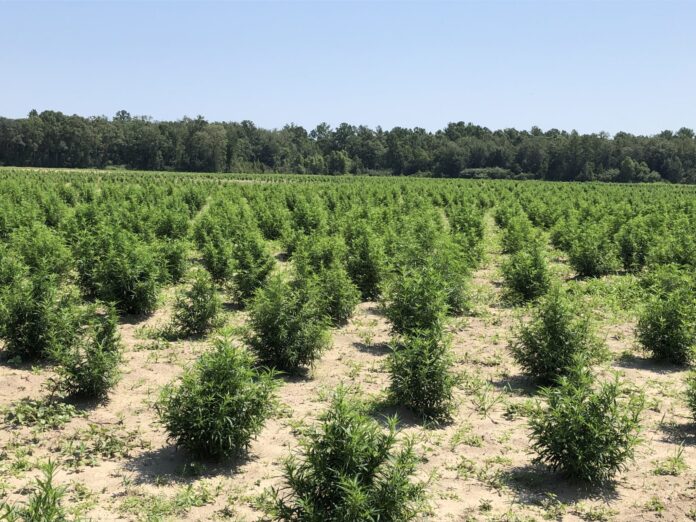AUBURN UNIVERSITY, Ala. – Hemp production is still at the forefront of many Alabama producers’ minds as early reports indicate an increase in the number of registered growers in 2021.
The Alabama Department of Agriculture and Industries (ADAI) is still in the process of approving applications for the 2021 growing season. Alabama Extension Entomologist and leader of the hemp action team, Katelyn Kesheimer, said a decrease in total acreage despite the increase in grower numbers is likely.
“After a couple of years of experience under our belt here in Alabama we are learning just how much time and labor it takes to produce a quality hemp crop,” she said. “Many growers with large-scale operations have decided to grow less in favor of higher quality pants.”
Extension involvement
Alabama Extension has an extension and research permit through ADAI. Agents and specialists are able to visit fields, make recommendations and transport samples back to the laboratory if necessary.
The Plant Diagnostic Laboratory on the Auburn University (AU) campus can diagnose disease issues and run leaf tissue analysis.
The research license allows cultivation on a research farm, as well as in a greenhouse. Kesheimer said she looks forward to investigating issues growers have faced indoors and outdoors during the last couple of years.
Growing regulations
Kesheimer said each state is still individually regulating pesticide use for the 2021 season.
“Here in Alabama, we have a list of approved pesticides (insecticides, miticides, herbicides and fungicides) that can be legally applied to hemp,” she said. “While these products are legal, we lack efficacy data on many of them. Growers should still utilize other integrated pest management strategies and avoid relying solely on chemical control.”
The U.S. Department of Agriculture (USDA) issued a Final Rule on Jan. 15, 2021. The document contains details surrounding tetrahydrocannabinol (THC) concentrations and testing procedures and disposal of ‘hot’ hemp, as well as harvest procedures. Plans are for the final rule to take effect March 22. However, the transition to a new administration could delay things.
The final rule did not increase THC limits beyond 0.3%; however, growers will have a longer harvest window. The rule also proposes an increase to the negligent threshold level, so growers avoid criminal sanctions if the crop has high THC levels.
Alabama hemp
“The main thing we have learned is that we still have so much to learn,” Kesheimer said. “Hemp has not been grown legally in the U.S. prior to the most recent Farm Bills, so we are lacking a thorough history of research on this crop.”
Researchers are working hard to begin research programs that will allow them to develop local recommendations for producers.
“Hemp grows differently in Alabama than it does in other parts of the U.S., so we need to really focus our efforts on studies that can help growers in this region,” she said. “Alabama has a long growing season with high temperatures, humidity, and moisture. Lots of insects and diseases also find their way to hemp, especially outdoors.”
Kesheimer said it is important to understand that hemp and marijuana are extremely different. While both are Cannabis sativa, the plants contain major difference in plant chemical composition and have varied end usage.
“Hemp only contains a delta-9 THC concentration of 0.3% or less,” she said. “Marijuana has much higher THC levels and is the chemical that produces psychoactive effects when consumed. While the majority of hemp in Alabama is grown for cannabinoids (CBD), it can also be grown for grain and fiber.”
Hemp uses
The essential oils from CBD hemp get a lot of the attention. However, Kesheimer said people can regularly use the grain and fiber products.
“Hemp seeds are technically a nut and are known for their nutritional value,” she said. “They have a mild nutty flavor and are often referred to as hemp hearts. Hemp hearts are the soft inner part of the seed after the outer shell has been removed.”
Seeds can be pressed to make oil. People can separate the stalk of fiber hemp into an outer layer and soft, woody inner layer. Kesheimer said each layer has unique properties that can be made into building material, clothing, rope, paper or carpet materials.
Alabama has hemp fiber processing materials, giving growers the option to grow different types of hemp with different post-harvest possibilities.
Hemp webinar
Tune in to the team’s bi-monthly webinar on the first and third Wednesdays of the month. Covering a wide variety of topics pertaining to Alabama’s growing hemp industry, the HEMP (hemp education and management program) webinar series will have something for experienced and novice growers.
Visit www.aces.edu/blog/topics/crop-production/hemp-webinar-series for more information.
More information
The team has a variety of resources available for growers and interested individuals on the Alabama Extension website. Extension personnel are also available to answer questions and assist in the field. Contact your local Extension office for more information.



















